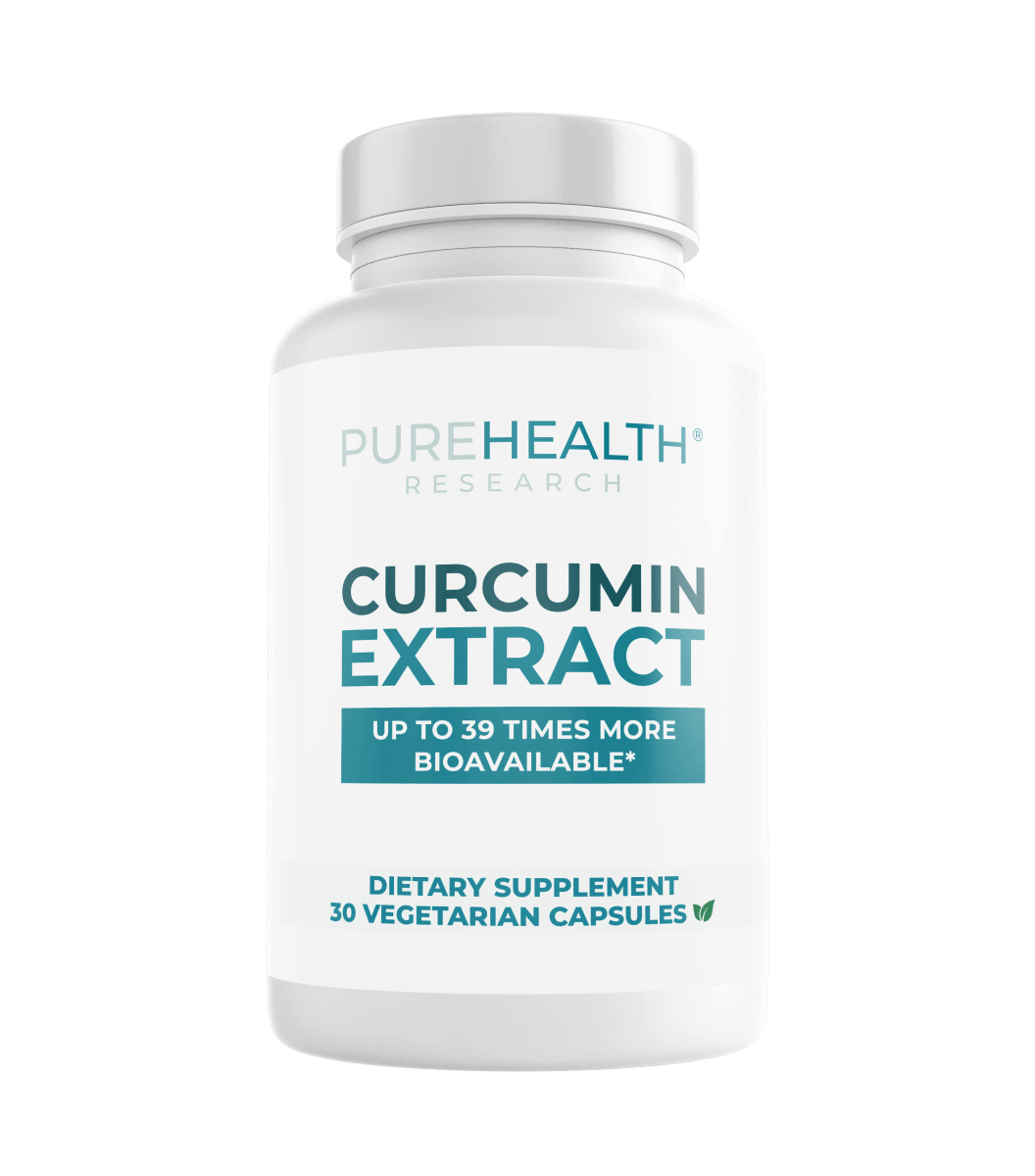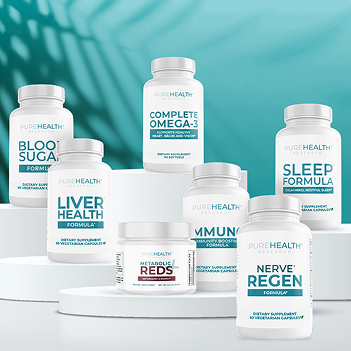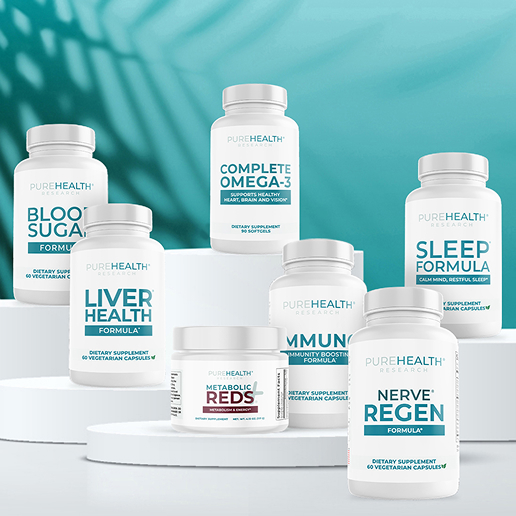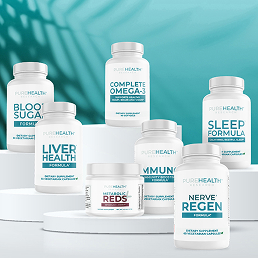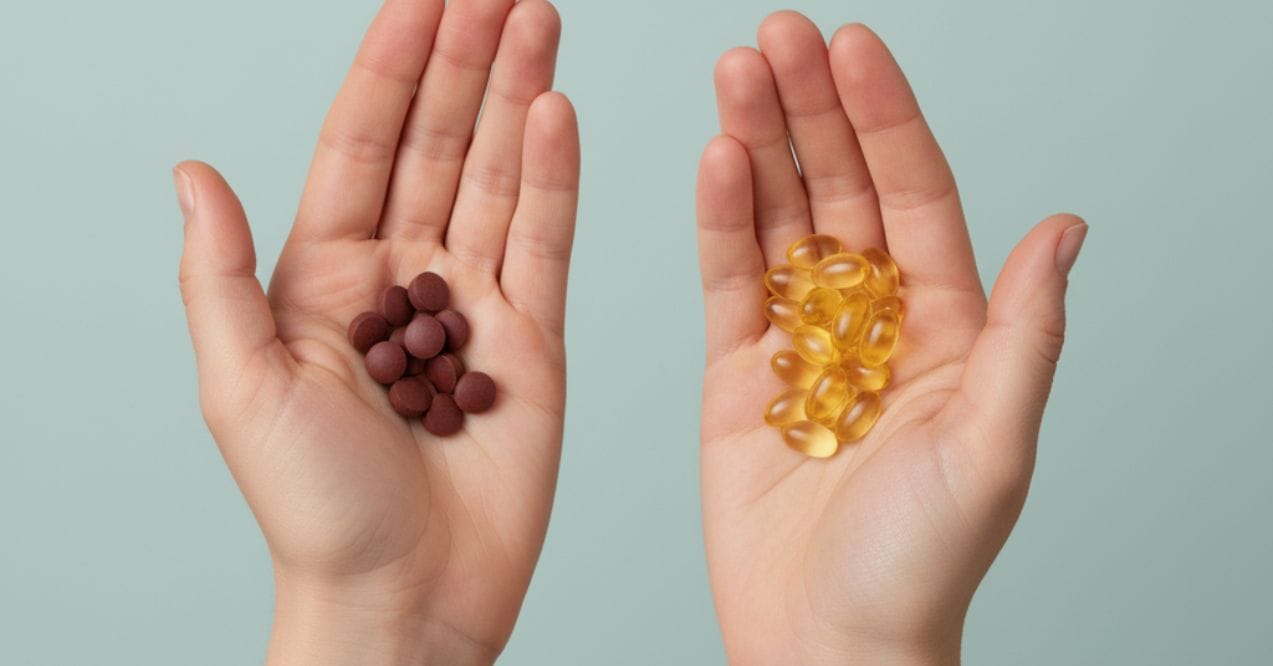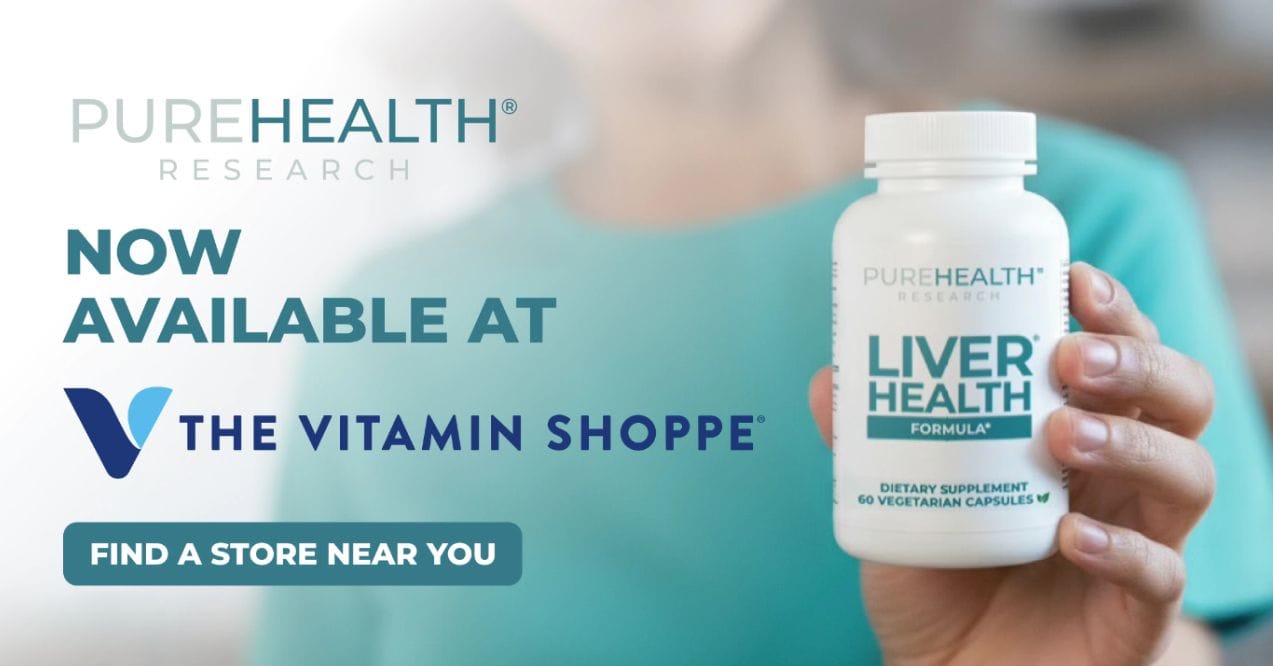Is Irish Moss the Same as Sea Moss?
Is Irish moss the same as sea moss? Learn their differences, benefits, and best ways to use these sea vegetables in your wellness routine.
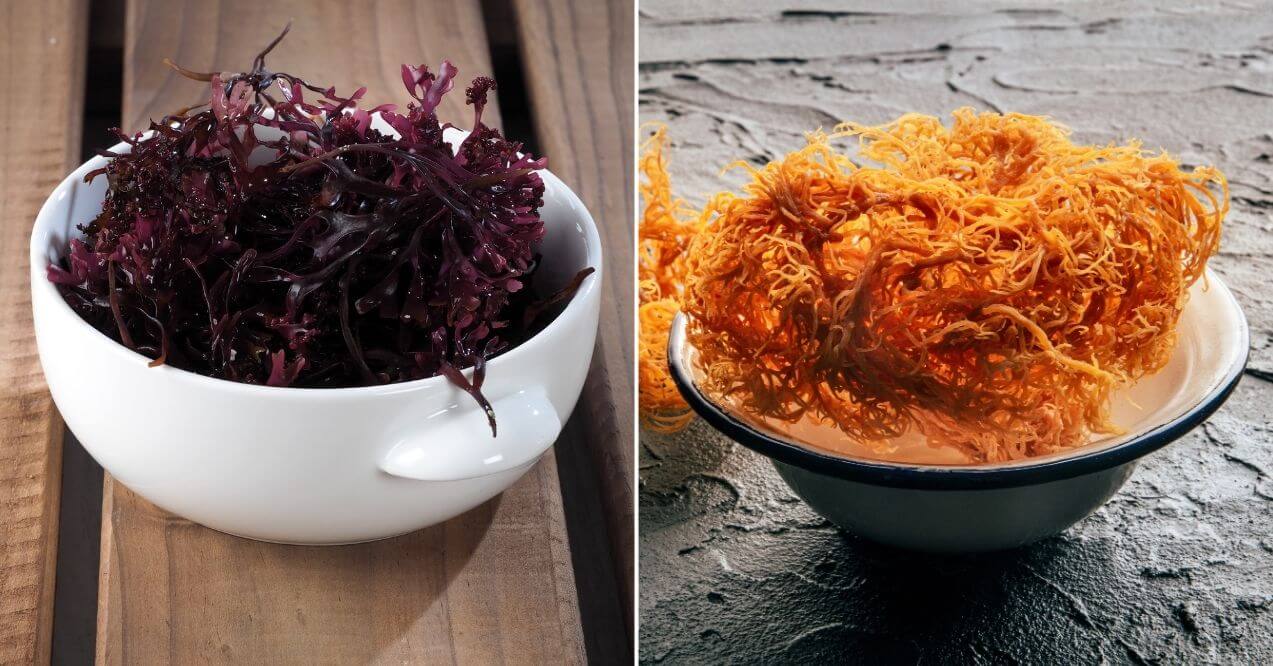

Walk along any health food store aisle or scroll through wellness influencers’ feeds, and you’ll likely spot sea moss and Irish moss products prominently displayed. These ocean-sourced superfoods have surged in popularity, appearing in everything from smoothies to skincare.
Yet many people wonder: is Irish moss the same as sea moss? Despite their similar names and appearance, these two marine plants are distinct entities with unique properties. While both offer impressive nutritional profiles, they differ in origin, appearance, and traditional uses.
This guide will unravel the confusion between Irish moss and sea moss, explore their individual benefits, and help you determine which might better support your wellness goals. We’ll also share practical tips for identifying quality products and incorporating these sea vegetables into your daily routine.
What is Irish Moss?
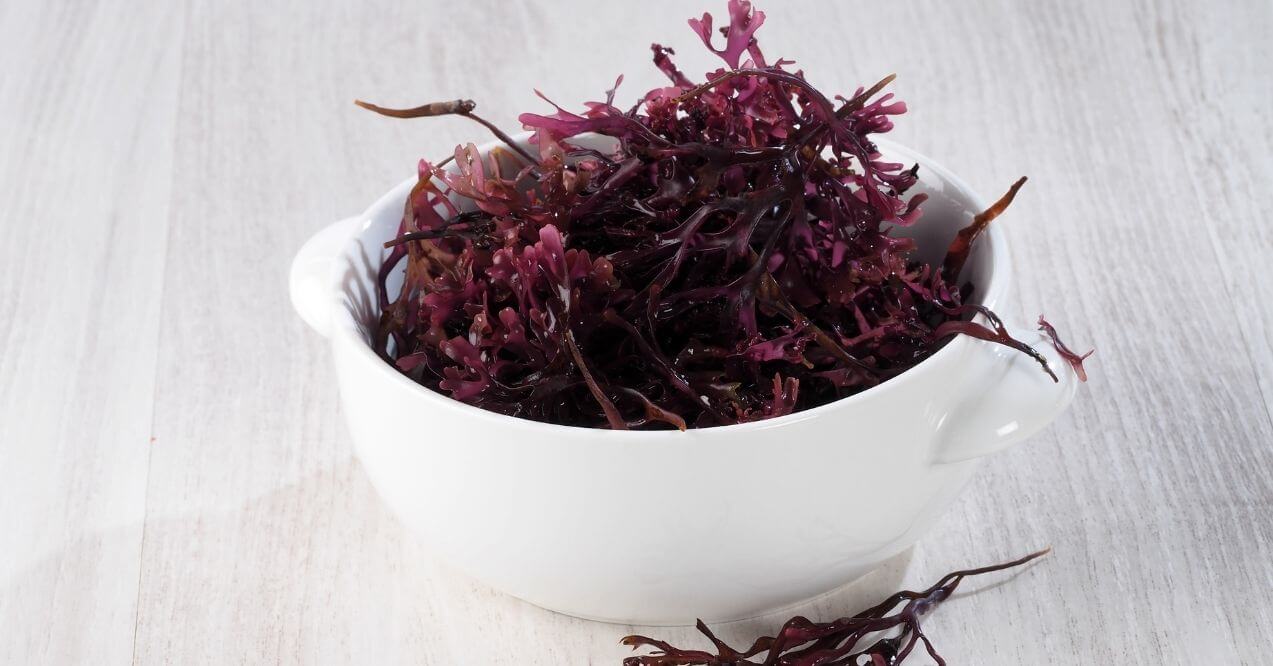
Irish moss, scientifically known as Chondrus crispus, is a specific species of red algae that thrives in the cold waters of the North Atlantic Ocean. This remarkable sea plant features a distinctive fan-like structure with flat, branching fronds that create a carpet-like appearance when growing on rocky coastlines.
In its natural habitat, Irish moss typically displays a deep reddish-purple hue, though it can appear dark brown or even greenish depending on growing conditions and sun exposure. The plant has adapted perfectly to cooler temperatures, making it abundant along the shores of Ireland, North America, and other northern Atlantic regions.
Irish moss holds a significant place in Irish history and culture, where it has been harvested for hundreds of years. During the devastating Irish Potato Famine of the 1840s, this nutritious seaweed became a crucial food source that helped many survive through desperate times.
Today, Irish moss serves multiple purposes in our modern world:
- As a natural thickening agent in foods like ice cream and puddings
- In skincare formulations to promote moisture retention and softness
- As a nutrient-rich addition to wellness routines, often prepared as a gel
The unique compounds in Irish moss, particularly its natural carrageenan content, make it valuable both as a functional ingredient and as a nutritional supplement in various wellness practices.
What is Sea Moss?
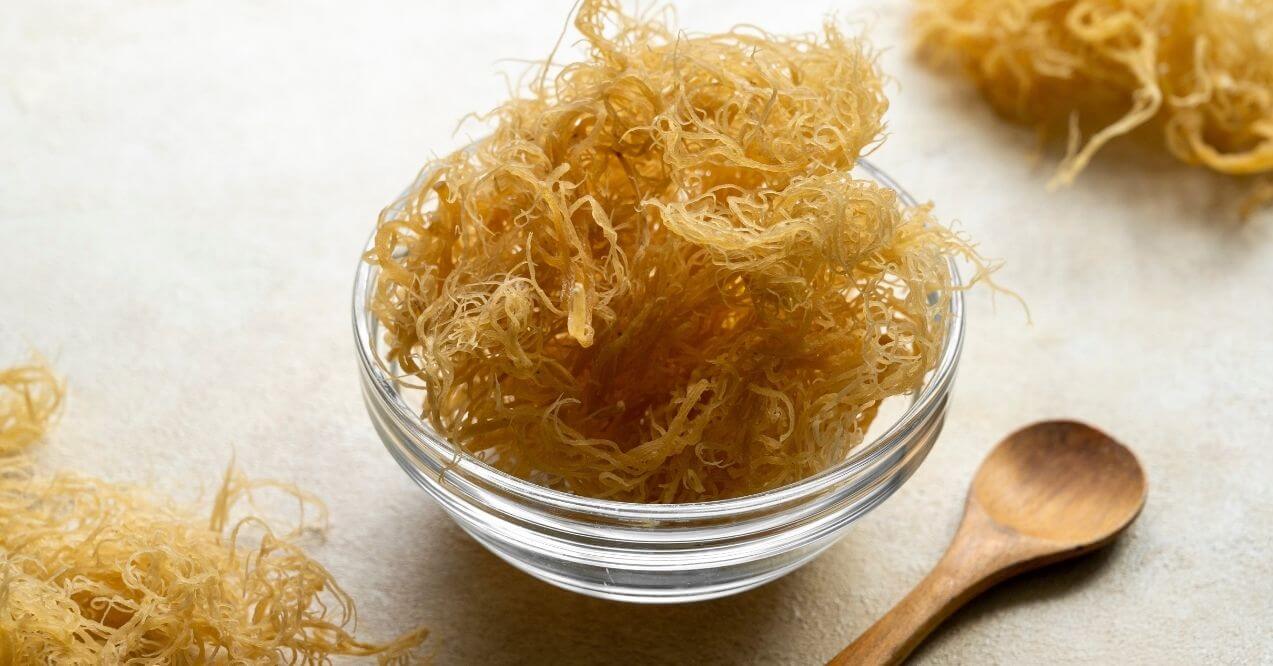
Sea moss refers to a broader category of red algae, with Gracilaria species being the most commonly marketed variety. Unlike Irish moss, sea moss flourishes in the warmer waters of the Caribbean Sea, Atlantic coastlines, and parts of Asia.
This marine plant features a more delicate structure with thin, string-like branches that create an intricate, mesh-like appearance. Sea moss typically displays lighter coloration, ranging from golden yellow to pale green or even purple, depending on its specific variety and growing environment.
Caribbean cultures have treasured sea moss for generations, incorporating it into traditional tonics and wellness practices. High-quality sea moss products maintain these cultural preparations while adhering to modern sourcing and processing standards.
Sea moss forms a slightly different gel compared to Irish moss – often lighter and less rigid – making it ideal for:
- Smoothies and beverages
- Plant-based milk alternatives
- Skin hydration formulas
- Daily wellness supplements
Many people who enjoy sea moss also incorporate Curcumin into their daily routines. Curcumin Extract supplements feature 100% Curcugen® in a unique formulation that’s 52.5 times more bioavailable than standard 95% curcuminoid extracts. This exceptional absorption helps maintain balanced inflammatory responses throughout your body.
This premium, bioactive ingredient in Curcumin Extract works to support healthy oxidative balance in organs, joints, and tissues. Like quality sea moss, this carefully formulated supplement offers an effective way to maintain your body’s natural balance and promote long-term wellness.
Is Irish Moss the Same as Sea Moss? Understanding the Key Differences
When comparing Irish moss vs sea moss, it’s easy to see why confusion exists. While they share similar names and both come from the ocean, they are not the same plant. Is sea moss and Irish moss the same? The short answer is no. These two sea vegetables differ in several important ways that affect their appearance, uses, and properties.
Origin & Classification
Irish moss and sea moss originate from completely different parts of the world, which influences their characteristics:
Irish moss (Chondrus crispus) thrives in the cold waters of the North Atlantic Ocean, particularly along the rocky coastlines of Ireland, Northern Europe, and northeastern North America. This hardy seaweed has adapted to withstand cooler temperatures and rougher waters.
Sea moss (typically Gracilaria species) prefers the warmer, tropical waters of the Caribbean, Atlantic coastlines of South America, and parts of Southeast Asia. This environment contributes to its more delicate structure.
While both belong to the broader red algae family (Rhodophyta), they represent distinct genera and species with different genetic makeups.
Common Uses
The traditional applications of these seaweeds reflect their cultural origins:
Irish moss has deep roots in European and North American culinary traditions. It’s widely used in commercial food production as a stabilizer and thickening agent. You’ll find it in ice creams, puddings, and many processed foods listed as carrageenan on ingredient labels.
Sea moss features prominently in Caribbean wellness traditions. It’s typically prepared as a gel for smoothies, drinks, and tonics. Its rising popularity has made it a common ingredient in modern supplements, wellness shots, and plant-based preparations.
Appearance & Texture
Visual differences make these seaweeds relatively easy to distinguish:
Irish moss grows in short, bushy clumps with flat, fan-like blades. It typically has a thicker, more substantial structure that feels somewhat leathery when dried. Its coloration tends toward deeper purples and reds, often appearing nearly black when dried.
Sea moss grows in long, thin strands with a more delicate, string-like appearance. When dried, it feels lighter and more brittle. Its coloration ranges from golden to yellow, light green, or purple depending on the variety and growing conditions.
Thickening Properties (Carrageenan)
Both plants contain natural carrageenan, but with important differences:
Irish moss contains a higher concentration of carrageenan, making it an exceptionally effective thickener. This property explains its widespread use in commercial food production where consistent gelling is essential.
Sea moss contains a different composition of carrageenan compounds, resulting in a lighter gel with less firmness. This creates a smoother texture that blends more easily into beverages and doesn’t set as rigidly as Irish moss preparations.
Irish Moss vs. Sea Moss Benefits
Both Irish moss and sea moss offer impressive nutritional profiles that have made them increasingly popular in wellness circles. What are the benefits of sea moss and Irish moss? While they share many similar properties, they do have some unique attributes based on their different growing environments and species characteristics.
| Benefit | Irish Moss | Sea Moss | Notes |
| Rich in Iodine | ✓ | ✓ | Both support thyroid function; sea moss contains slightly higher amounts |
| Vitamins A, E, F, and K | ✓ | ✓ | Essential for immune function and skin health |
| Potassium content | ✓ | ✓ | Sea moss is a source of potassium, a mineral involved in many bodily functions. |
| Zinc | ✓ | ✓ | Important for immune support and wound healing |
| Calcium | ✓ | ✓ | Both support bone health; comparable amounts |
| Anti-inflammatory properties | ✓ | ✓ | Support a balanced inflammatory response |
| Digestive health | ✓ | ✓ | Irish moss has stronger mucilaginous properties |
| Skin benefits | ✓ | ✓ | Both can be used in topical applications |
| Respiratory support | ✓ | ✓ | Traditional use for congestion and respiratory conditions |
| Weight management | ✓ | ✓ | Help promote feeling of fullness |
| Carrageenan content | ✓ | Unique to Irish moss; used as a thickening agent | |
| Protein content | ✓ | Sea moss contains approximately 6g of protein per 100g | |
| Vitamin C | ✓ | ✓ | Sea moss contains moderate amounts; Irish moss has trace amounts |
| B vitamins | ✓ | Sea moss contains B1, B2, B3, B5, B6, and B12 | |
| Magnesium | ✓ | Sea moss is particularly rich in this mineral for muscle relaxation |
Some users also ask: does sea moss increase libido? Traditional Caribbean wellness practices have indeed used sea moss as a vitality tonic, with some anecdotal reports suggesting potential benefits for reproductive health. However, scientific research in this specific area remains limited.
Nevertheless, both varieties offer impressive nutritional value, making them worthwhile additions to a balanced wellness routine. The choice between them often comes down to specific needs, preferences in texture and taste, and the particular application you have in mind.
How to Identify Irish Moss and Sea Moss?
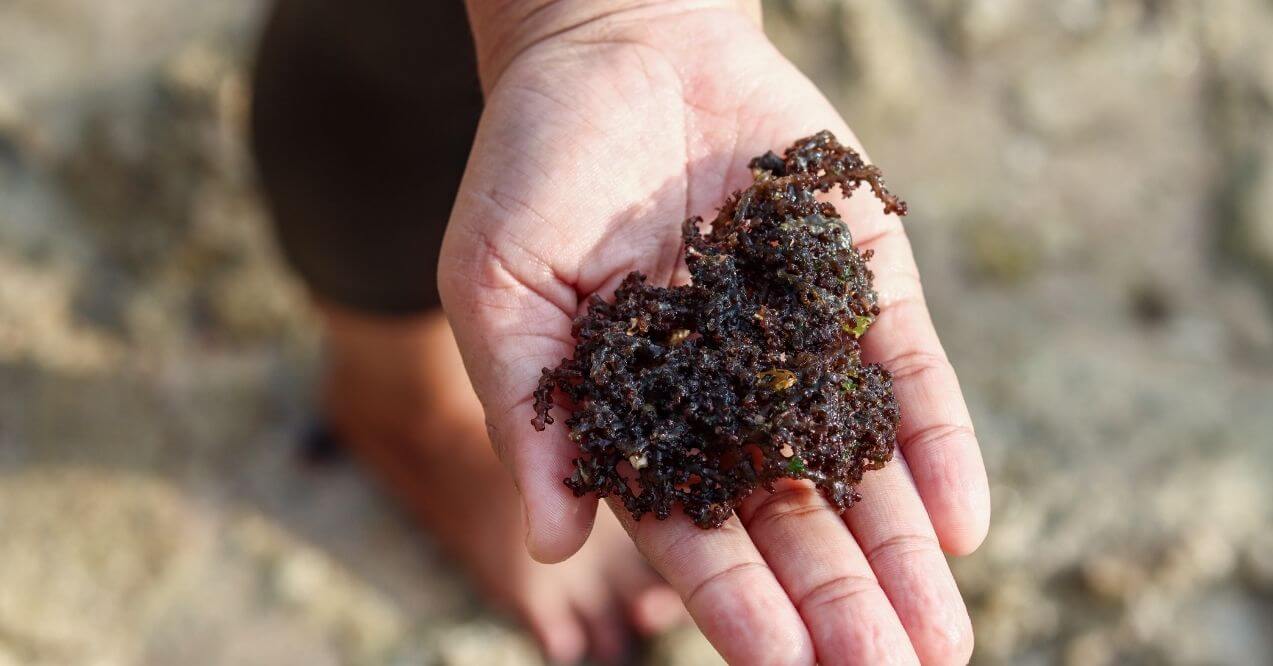
When shopping for these beneficial sea vegetables, knowing how to distinguish between Irish moss vs sea moss helps ensure you get the product that best suits your needs. With the growing popularity of sea moss benefits, the marketplace has seen an influx of products with varying levels of quality and authenticity.
Here’s how to identify which type you’re looking at and assess its quality:
Color as a Key Indicator:
- Irish moss typically displays darker colors – deep red, purple, or almost black when dried
- Sea moss (Gracilaria) usually shows lighter hues – golden, yellow, tan, or light green
- Natural color variations exist within each type, so color alone isn’t definitive
Structural Differences:
- Irish moss appears fan-like with flat, broad fronds and a more compact structure
- Sea moss features thin, string-like branches that create a more delicate, web-like appearance
- When dried, Irish moss tends to feel more substantial while sea moss feels lighter and more brittle
Quality Indicators:
- High-quality dried sea moss should snap when bent, not bend like rubber
- Avoid products with excessive salt deposits (white coating) or overwhelming fishy odors
- The best specimens have relatively consistent coloration without excessive discoloration
- Minimal debris or foreign matter indicates better processing and handling
Signs of Processing:
- Some commercial products undergo bleaching or dyeing to achieve a “perfect” golden color
- Natural sea moss has slight variations in color throughout the plant
- Unusually bright gold or perfectly uniform coloring may indicate chemical processing
- Excessively soft texture in dried sea moss can suggest chemical treatment
Sourcing Considerations:
- Wild-harvested varieties typically offer more nutritional value than pool-grown options
- Products should clearly state their origin – Caribbean, Atlantic, or other specific regions
- Reputable suppliers provide transparency about harvesting and processing methods
- Organic certification can offer additional assurance of quality and purity
Understanding these distinctions ensures you can maximize the sea moss benefits you’re seeking, whether you choose Irish moss for its superior gelling properties or sea moss for its traditional tonic applications.

Incorporating Irish Moss & Sea Moss into Your Routine
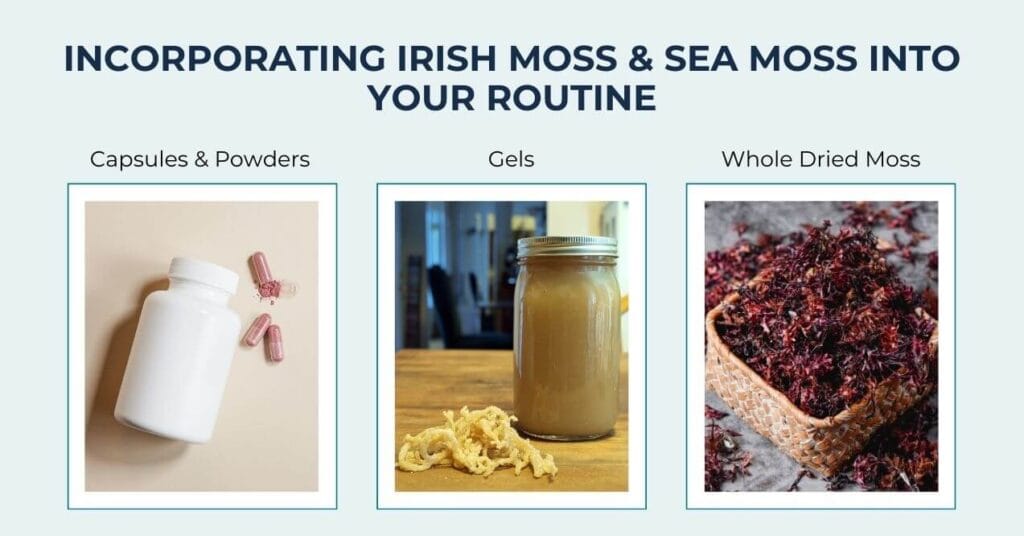
Adding either Irish moss or sea moss to your wellness routine can be straightforward once you understand the different forms available. Both varieties can be incorporated in several practical ways that fit various lifestyles and preferences.
Capsules & Powders
For those with busy schedules or who prefer simplicity, capsules and powders offer convenient options:
- Capsules provide precise dosing without any preparation needed
- Simply take with water at your regular supplement time
- Powders can be stirred into beverages without creating the thick texture of gels
- Many powders are tasteless, making them easy to add to juices or water
Gels
Sea moss gel is perhaps the most versatile and traditional preparation method:
- To make your own: soak dried moss in water for 12-24 hours, rinse thoroughly, then blend with fresh water
- Store homemade gel in the refrigerator and use within 2-3 weeks
- Add 1-2 tablespoons to smoothies, plant milks, or teas
- Mix into soups and sauces as a natural thickener
- Apply directly to skin as a hydrating mask or moisturizer
- Use as a base for homemade hair treatments
Whole Dried Moss
Working with whole dried moss requires more effort but offers the most authentic experience:
- Purchase from reputable sources to ensure quality and proper identification
- Soak in cold water for several hours until it expands and softens
- Rinse thoroughly to remove any salt or debris
- Can be eaten directly after soaking (common in some traditional diets)
- Process into gel using a blender for the most versatile preparation
- Some prefer Irish moss for culinary applications and sea moss for wellness tonics
Whichever form you choose, start with small amounts to see how your body responds. The mineral content of seaweeds can vary, so moderation is key to enjoying their benefits comfortably.
Final Takeaways
So, is Irish moss the same as sea moss? While they share some similarities, they are distinct sea vegetables with unique properties. Irish moss (Chondrus crispus) thrives in cold Atlantic waters with a fan-like structure, while sea moss (Gracilaria) prefers warmer Caribbean environments with its stringy appearance.
Both offer impressive nutritional profiles that can support overall wellness when incorporated into your routine. The best choice depends on your specific needs – Irish moss excels in thickening applications, while sea moss is traditionally valued in tonic preparations.
Remember that quality matters significantly. Choose products from reputable sources that provide transparency about harvesting methods and processing. Your wellness journey deserves authentic, carefully sourced ingredients.
Neither is objectively “better” – they have different properties. Irish moss excels as a thickener with higher carrageenan content, while sea moss is traditionally used in tonics and has a lighter gel texture. Choose based on your specific needs and preferences.
People with iodine sensitivities, thyroid conditions, or shellfish allergies should consult a healthcare provider before using either moss. Those on blood-thinning medications or with certain digestive conditions may also need to exercise caution.
Irish moss supports digestive health, provides minerals and antioxidants, serves as an excellent natural thickener in foods, and has traditionally been used for respiratory comfort. Its gel can be applied topically for skin hydration.
The best form depends on your lifestyle. Gel offers versatility for culinary and topical uses. Capsules and powders provide convenience. Whole dried moss gives you control over preparation but requires more effort.
Sign up for our Healthy Living newsletter!
Advertisement. This site offers health, wellness, fitness and nutritional information and is designed for educational purposes only. You should not rely on this information as a substitute for, nor does it replace, professional medical advice, diagnosis, or treatment. If you have any concerns or questions about your health, you should always consult with a physician or other health-care professional. Do not disregard, avoid or delay obtaining medical or health related advice from your health-care professional because of something you may have read on this site. The use of any information provided on this site is solely at your own risk.
